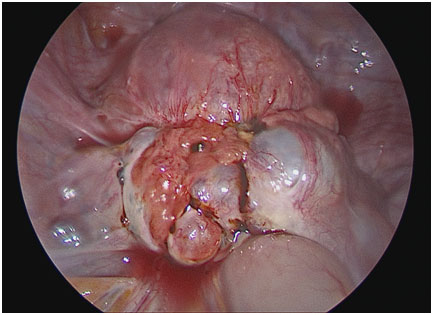Unfreezing the Frozen Pelvis

The Frozen Pelvis is often described as the most complex pathology that gynecologists encounter. It is synonymous with end stage disease.

Frozen pelvis is the most extensive form of advanced endometriosis.
It may be a partial or total frozen pelvis.
We use the term frozen pelvis because deep fibrotic nodules and deep infiltrative endometriosis replace pelvic soft tissues with high density fibrosis.
Pelvic organs soon become firmly fixed to pelvic bones, making them immobile or frozen comparable to how ice feels.
Often considered to be the most difficult pathology to take on in #gynecology . With the advent of #laparoscopy and #laparoscopictraining improving, the vision the scope afforded far exceeded that of what open surgery did . So in the correct hands a frozen pelvis should preferably be treated laparoscopically and an open procedure should be avoided. #endometriosis with a frozen pelvis is truly difficult surgery due to distortion of the anatomy, constant oozing by newly formed blood vessels in the surgical field. Unfortunately many surgeons feel that they should just do as much as they can and then hope that medication takes care of the rest (this very rarely actually works). We at #ICE try and advocate that if one stumbles upon this pathology it is better to do nothing and come out and refer the patient to a specialist rather than create further surgical insult and undertreat the disease furthermore making the next surgeons job significantly more difficult. #endometriosisawareness #endometriosisindia #womenshealth #infertility #india

DIFFERENCE BETWEEN STAGE 4 ENDOMETRIOSIS AND A FROZEN PELVIS ?
The Staging of Endometriosis is done after a laparoscopic survey to tabulate the extent of the disease. We know that existing staging systems are inherently flawed, but for the sake of comparision, the r-ASRM system is the easiest to work with.
The Frozen pelvis on the other hand is diagnosed clinically and confirmed via ultrasonography examination by an experienced endometriosis specialist.
D/D for frozen pelvis –Endometriosis –Cancer –Pelvic Inflammatory disease –Radiation treatment –Previous surgery (Especially myomectomy).
For this post we will focus on the frozen pelvis in endometriosis.

LAPAROSCOPY OR LAPAROTOMY?
During residency we were wrongly taught that a frozen pelvis was a contra indication for the laparoscopic approach.
Today I say that a laparotomy is contra indicated for a frozen pelvis.
One cannot decipher tissue planes required for restoration of normal anatomy without the vision and magnification that laparoscopy offers.
Laparoscopy has come a long way with amazing technologies available like HD, Ultra HD, 4K, 3-D and there are developments for VR and AR which are very interesting concepts and should prove to be game changers in standards of care.
To achieve excellence in laparoscopy is to perform a succession of coordinated manouvers efficiently. Therefore formalised fellowship training is key.
But laparoscopy is a very cruel mistress and one misstep requires 10 corrective steps, which accounts for the incredibly long learning curve and the dearth of properly trained minimally invasive surgeons.
Once we understand our limitations then we can define our strategy to overcome those limitations.
WHO SHOULD PERFORM SURGERY FOR A FROZEN PELVIS ?
This has always led to some debate. Should it be the Gynecologists, the General surgeons, urologists , gyn-oncologists or feritilty specialists ?
The answer is a complex one. Inadequate treatments from experienced laparoscopic surgeons untrained in excision of endometriosis resulted in recurrence rates of upto 35% . The multidisciplinary approach is the way to go because Endometriosis is not a gynecological specific disease. It affects numerous organ systems in the body and requires a holistic approach to treat the disease. Therefore advanced endometriosis cases must be dealt with at an endometriosis centre by a multidisciplinary team.
SURGICAL STRATEGY
The whole premise of endometriosis surgery is unscrambling and restoring the anatomy
In laparoscopy exposure is key , The eye sees what the mind knows and also what your assistant holding the camera shows you. Therefore it is prudent to have a well trained and coordinated team.
There is no room for the superstar surgeon, rather, you are only as good as the weakest member of your team.
Dissection requires a grasping bipolar on the one side, atrautatic grasping forceps on your assistants side and cold scissors in the middle: The principle is the two opposing forces delineate the planes or the white line which is the road map of where to cut. There are numerous energy modalities available and it truly is a case of dealer’s choice and what the surgeon is most comfortable with.
One must be prudent with the bipolar coagulation keep bleeding to a minimum, DO NOT IRRIGATE as far as you can avoid it as it ruins the field of dissection
The approach is from the familiar anatomy to the unfamiliar, working laterally to medial. The surgeon must be very familiar with the retroperitoneal anatomy as these may be the only “normal” landmarks to guide the dissection.
In bowel excisions it is prudent to perform the insufflation tests with air and/ or methylene blue at the end of the surgery.
